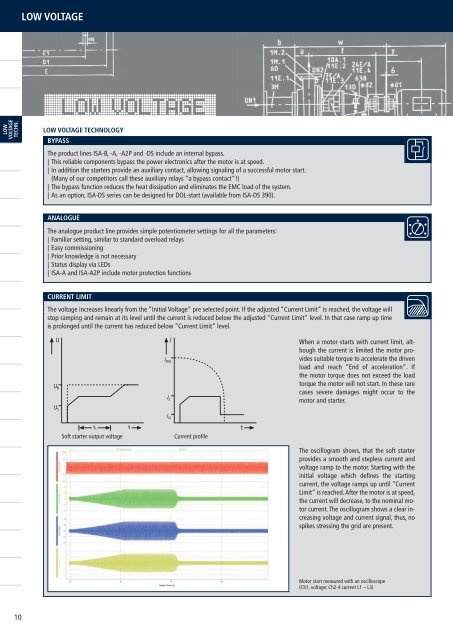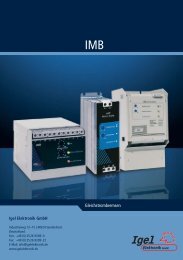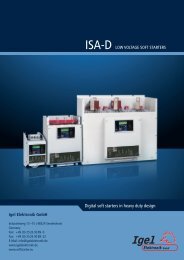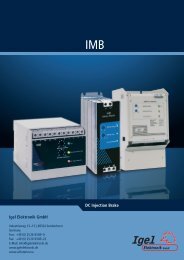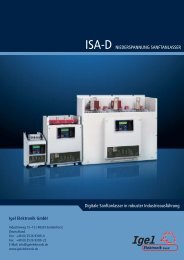isa-drive-e - Igel Electric
isa-drive-e - Igel Electric
isa-drive-e - Igel Electric
- TAGS
- igel
- igelelectric.de
Create successful ePaper yourself
Turn your PDF publications into a flip-book with our unique Google optimized e-Paper software.
LOW<br />
VOLTAGE<br />
TECHN.<br />
10<br />
LOW VOLTAGE<br />
LOW VOLTAGE<br />
LOW VOLTAGE TECHNOLOGY<br />
BYPASS<br />
The product lines ISA-B, -A, -A2P and -DS include an internal bypass.<br />
| This reliable components bypass the power electronics after the motor is at speed.<br />
| In addition the starters provide an auxiliary contact, allowing signaling of a successful motor start.<br />
(Many of our competitors call these auxiliary relays “a bypass contact“!)<br />
| The bypass function reduces the heat dissipation and eliminates the EMC load of the system.<br />
| As an option, ISA-DS series can be designed for DOL-start (available from ISA-DS 390).<br />
ANALOGUE<br />
The analogue product line provides simple potentiometer settings for all the parameters:<br />
| Familiar setting, similar to standard overload relays<br />
| Easy commissioning<br />
| Prior knowledge is not necessary<br />
| Status display via LEDs<br />
| ISA-A and ISA-A2P include motor protection functions<br />
CURRENT LIMIT<br />
The voltage increases linearly from the “Initial Voltage“ pre selected point. If the adjusted “Current Limit“ is reached, the voltage will<br />
stop ramping and remain at its level until the current is reduced below the adjusted “Current Limit“ level. In that case ramp up time<br />
is prolonged until the current has reduced below “Current Limit“ level.<br />
U<br />
U N<br />
U S<br />
t 1<br />
Soft starter output voltage<br />
t<br />
/ S<br />
/<br />
/ DOL<br />
/ N<br />
Current profile<br />
t<br />
When a motor starts with current limit, although<br />
the current is limited the motor provides<br />
suitable torque to accelerate the <strong>drive</strong>n<br />
load and reach “End of acceleration“. If<br />
the motor torque does not exceed the load<br />
torque the motor will not start. In these rare<br />
cases severe damages might occur to the<br />
motor and starter.<br />
The oscillogram shows, that the soft starter<br />
provides a smooth and stepless current and<br />
voltage ramp to the motor. Starting with the<br />
initial voltage which defi nes the starting<br />
current, the voltage ramps up until “Current<br />
Limit“ is reached. After the motor is at speed,<br />
the current will decrease, to the nominal motor<br />
current. The oscillogram shows a clear increasing<br />
voltage and current signal, thus, no<br />
spikes stressing the grid are present.<br />
Motor start measured with an oscilloscope<br />
(Ch1, voltage; Ch2-4 current L1 – L3)


